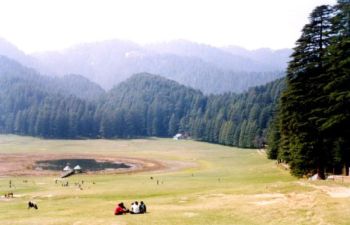Shimla: Successive governments in Himachal Pradesh may have left high and dry the picturesque natural lake in an area dubbed “mini Switzerland” by the then Swiss envoy way back in 1992. But the parched and struggling-to-live-again Khajjiar Lake may soon get a new lease of life.
In an attempt to prevent the lake – ringed by dense pine and cedar groves in Khajjiar, a saucer-shaped plateau near Chamba town 450 km from state capital Shimla – from being pushed into oblivion, the National Green Tribunal (NGT) has come to its rescue.
The NGT’s principal bench headed by Justice Swatantar Kumar, in its order July 29, said: “The Union of India, along with the state government, shall take effective steps to revive the water body at Khajjiar and ensure its restoration to the original status as it existed in the past.”
Official sources told that the Khajjiar Lake, one of the national wetlands located at an altitude of 1,951 metres in the Dhauladhar range, has shrunk in recent years owing to siltation and unchecked growth of weeds.
“Due to silting, the lake’s storage capacity has massively declined. This results in overflowing of rainwater,” said an official of the state Council for Science and Technology and Environment, the nodal agency for monitoring all water bodies.
Studies by the council say unregulated grazing by livestock near the lake glade has deteriorated the grassy patch.
“Hoofs of livestock and ponies used by the tourists have loosened the soil, making the lake prone to siltation,” said an official, who didn’t wish to be identified.
He said even the water of the lake has turned acidic as quintals of cow dung daily flow into it.
For the locals, the lake is sacred as it’s linked to the Khajjinag deity, whose temple is located in the lake’s vicinity.
“Besides its religious significance, it’s the lung of the region. Half of the lake has vanished and the rest will soon vanish,” local resident Narinder Thakur lamented.
While hearing a petition, the NGT bench, which also comprised Justice U.D. Salvi, observed: “Let the needful be done before the next date of hearing (Sep 16).”
“The ministry of environment and forests shall depute one of its officers immediately to guide the state government on the restoration plan, before the next date of hearing,” said the NGT bench, which conducted the hearing in the Himachal Pradesh High Court here.
It asked the deputy commissioner of Chamba to file a personal affidavit on the steps taken for removing the unauthorised encroachments and preventing non-forest activities in and around the lake and its catchment area.
K. Kaisth, principal scientific officer of the Council for Science and Technology and Environment, told that a management action plan to save and restore the Khajjiar Lake has already been sent to the ministry of environment and forests for funding.
He said the plan aims to desilt the lake, besides adopting scientific measures to check siltation and accumulation of weeds.
Officials said indiscriminate grazing should also be checked.
The glade of Khajjiar, which is part of the Khajjiar-Kalatop Sanctuary, is spread over 18.5 hectares.
The sanctuary supports wild animals like the musk deer, black bear, leopard, barking deer and goral. Pheasant species like the monal, koklas and kaleej are also in abundance.
Khajjiar town was christened “mini-Switzerland” by Swiss envoy Willy P. Blazer July 7, 1992. He put up a signboard which indicates the distance from Swiss capital Berne to Khajjiar is 6,194 km.
Officials said Khajjiar is the 160th tourist spot in the world to be christened “mini-Switzerland” as the Swiss have a tradition of naming such places that look alike to their country.
– IANS
The opinions, beliefs and viewpoints expressed by authors, news service providers on this page do not necessarily reflect the opinions, beliefs and viewpoints of Hill Post. Any views or opinions are not intended to malign any religion, ethnic group, club, organization, company, or individual.
Hill Post makes no representations as to the accuracy or completeness of any information on this site page.




